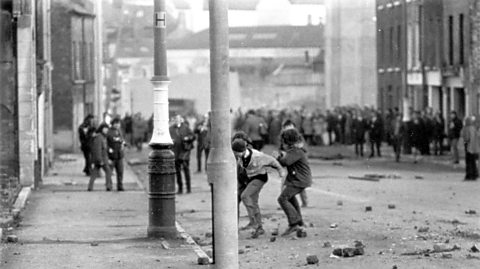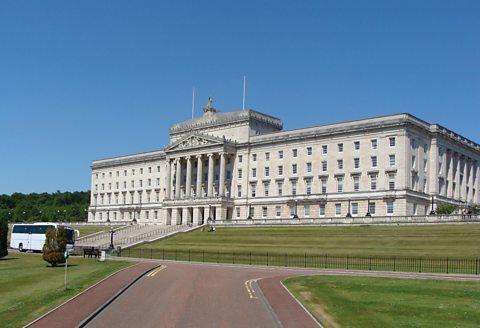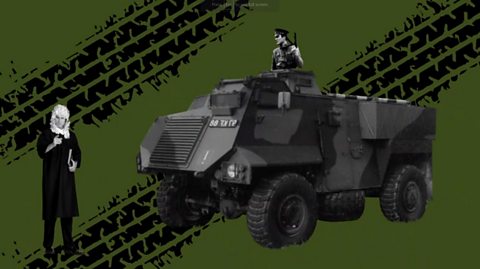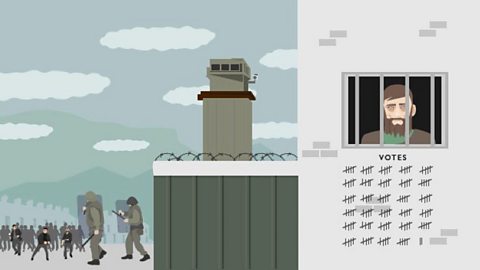Background
Due to continuing violence, and under pressure from members of his own party to do something that worked, Prime Minister Brian Faulkner decided to introduce internmentImprisonment without trial. to deal with those believed to be involved in terrorism.
Events
On 9 August 1971, Operation Demetrius started and 452 men were arrested.
However, those arrested were, by and large, the wrong people.
The information used by the authorities was out of date; those internmentImprisonment without trial. were mainly members of the Official IRA (OIRA), ordinary nationalistPeople who believe their country should be independent from other nations. For example, Irish nationalists, who want Ireland to be fully independent of Britain. or civil rights Rights everyone is entitled to regardless of the colour of their skin, their beliefs, sexuality, sex or other personal characteristics. These rights could include - amongst other things - the right to vote, the right to free speech or the right to a good education. supporters - not the Provisional Irish Republican Army (PIRA)Irish republican paramilitary group formed when members split from the Official IRA (OIRA) in 1969..
On top of that, no loyalistA person who, in terms of culture, identity and politics, retains a strong loyalty to Britain and firmly opposes a united Ireland. were arrested, even though loyalist paramilitaryA person or organisation that operates like a military force, but is not part of a country's official armed forces. were also involved in killings and bombings.
The first loyalists were not interned until February 1973.
Reactions
The introduction of internmentImprisonment without trial. resulted in a range of reactions:
- The levels of violence got much worse. In the last 4œ months of 1971, 143 people were killed and many homes and businesses were destroyed. Before internment was introduced, there had been fewer than 30 deaths in 1971.
- Despite being satisfied with the introduction of internment at first, unionistA person who believes the union between Britain and Northern Ireland should continue. support began to decline when it did not lead to a drop in the levels of bloodshed and destruction.
- Politicians from the Social Democratic and Labour Party (SDLP)An Irish nationalist party in Northern Ireland. When it was set up in August 1970, the SDLP was moderately left wing on social and economic issues. At the same time, the party sought political reforms within Northern Ireland and the eventual re-unification of Ireland. , nationalistPeople who believe their country should be independent from other nations. For example, Irish nationalists, who want Ireland to be fully independent of Britain. and Irish republicanA person who wants to establish an all Ireland republic completely independent of Britain. Labour Parties urged their supporters to show their opposition to internment by refusing to pay either their ratesA payment made by householders to their local council. or the rent due on their homes. In addition, politicians from these parties stopped attending council meetings.
- Provisional Irish Republican Army (PIRA)Irish republican paramilitary group formed when members split from the Official IRA (OIRA) in 1969. membership increased.
- The Northern Ireland Civil Rights Association (NICRA) responded by holding protest marches. However, these soon ran into trouble. When NICRA staged a march close to an internment camp at Magilligan, Co Londonderry, in January 1972, the army responded by firing CS gasA substance used to prevent rioting. Also known as âtear gasâ. and charging the marchers with their batons drawn.
Bloody Sunday

Despite this reaction from the military, another anti-internment protest was arranged to take place in Derry/Londonderry on 30 January 1972.
As the march ended, rioting began in the BogsideA nationalist area of Derry/Londonderry.; the Parachute RegimentA British Army regiment first set up in 1940.moved in and opened fire.
By the time the shooting had ended, 13 men had been killed.
An additional 13 were wounded; one of these later died from his injuries.
Reaction to Bloody Sunday
Following the events of what became known as Bloody Sunday, a number of things happened:
- Provisional Irish Republican Army (PIRA)Irish republican paramilitary group formed when members split from the Official IRA (OIRA) in 1969. membership grew â particularly in Derry/Londonderry - as did the levels of violence.
- While unionistA person who believes the union between Britain and Northern Ireland should continue. spoke of their regret at the numbers of deaths in Derry/Londonderry, they said that the civil rights Rights everyone is entitled to regardless of the colour of their skin, their beliefs, sexuality, sex or other personal characteristics. These rights could include - amongst other things - the right to vote, the right to free speech or the right to a good education. march was illegal and so should not have taken place at all.
- The British embassyA place where a foreign government houses an ambassador to represent them. in Dublin was burned by a crowd of nationalistPeople who believe their country should be independent from other nations. For example, Irish nationalists, who want Ireland to be fully independent of Britain.protesters. This clearly showed how angry some nationalists were at the actions of the British Government.
- Public opinion across the world criticised the British Governmentâs actions.
Inquiry
The London government responded by setting up an inquiry into the events of Bloody Sunday.
The investigation was led by Lord Widgery, the most senior British judge.
After listening to evidence, Widgery decided that the army had not been to blame for what had happened, but stated the armyâs actions âbordered on the recklessâ.
He also established that none of those who died had been carrying a weapon when shot.
Ulster Vanguard
The failure of the government to deal with the increase in levels of Irish Republican Army (IRA)A republican paramilitary group which was determined to create an Irish Republic as proclaimed in the 1916 Easter Rising. violence was criticised by unionists.
In February 1972, some responded by setting up a new political group, known as Ulster Vanguard.
Headed by former Minister William Craig, Vanguard was described as a co-ordinating body for traditional loyalistA person who, in terms of culture, identity and politics, retains a strong loyalty to Britain and firmly opposes a united Ireland. groups.
One of its meetings attracted 70,000 people.
Archive content from ±«Óătv: Ten Chapters of the Northern Ireland Troubles ()
WATCH: Internment
Test your knowledge
More on Changing relations: Northern Ireland and its neighbours, 1965-98
Find out more by working through a topic
- count6 of 11

- count7 of 11

- count8 of 11

- count9 of 11
